|
FAQs about Non-Vertebrate Animal Identification
53
Related Articles: Marine Invertebrates, Marine Invertebrate Systems, Marine Invertebrate Compatibility,
Marine Invertebrate Disease,
Marine Invertebrate
Reproduction, Quarantine of Corals and
Invertebrates, Feeding
Reef Invertebrates, Lighting
Marine Invertebrates, Water Flow, How Much
is Enough,
Related FAQs: Non-Vert IDs 1, Non-Vert IDs 2, Non-Vert IDs 3, Non-Vert IDs 4, Non-Vert IDs 5, Non-Vert IDs 6, Non-Vert IDs 7, Non-Vert IDs 8, Non-Vert IDs 9, Non-Vert IDs 10, Non-Vert IDs 11, Non-Vert IDs 12, Non-Vert IDs 13, Non-Vert IDs 14, Non-Vert IDs 15, Non-Vert IDs 16, Non-Vert IDs 17, Non-Vert IDs 18, Non-Vert. ID 19, Non-Vert. ID 20, Non-Vert. ID 21, Non-Vert. ID 22, Non-Vert. ID 23, Non-Vert. ID 25, Non-Vert ID 26, Non-Vert ID 27, Non-Vert ID 28, Non-Vert ID 29, Non-Vert ID 30, Non-Vert ID 31, Non-Vert ID 32, Non-Vert 33, Non-Vert ID 34 Non-Vert ID 35, Non-Vert ID 36, Non-Vert ID 37, Non-Vert ID 38, Non-Vert ID 39, Non-Vert ID 40, Non-Vert ID 41, Non-Vert ID 42, Non-Vert ID 43, Non-Vert ID 44, Non-Vert ID 45, Non-Vert ID 46, Non-Vert ID 47, Non-Vert ID 48, Non-Vert ID 49, Non-Vert ID 50, Non-Vert ID 51, Non-Vert ID 52, Non-Vert ID 54, Non-Vert ID 55, Non-Vert ID 56,
Non-Vert ID
57, Non-Vert ID 58,
Non-Vert ID 59,
Non-Vert ID 60, Non-Vert ID 61,
& Marine Invertebrates, Marine Invert.s 2, Marine Invert.s 3, & FAQs about:
Marine Invertebrate Behavior,
Marine Invertebrate
Compatibility, Marine
Invertebrate Selection, Marine
Invertebrate Systems, Feeding
Reef Invertebrates, Marine
Invertebrate Disease, Marine
Invertebrate Reproduction, &
& LR
Life Identification, LR Hitchhiker ID
1, Anemone Identification,
Aiptasia
Identification, Aiptasia ID 2,
Worm Identification, Tubeworm ID, Polychaete Identification, Snail Identification, Marine Crab
Identification, Marine Invert.s 1,
Marine Invert.s 2, Marine Plankton,
|
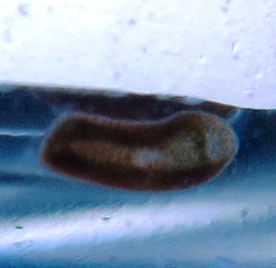 |
|
New critter for IDing 7/18/2010
Good Morning to you all. Bob, love the book!
I have found yet another critter last night with the flashlight.
I believe it to be a bivalve but I want to be sure. I noticed on
your website only a few photos
that look the similar as mine but I would like to be sure.
<This is unusual... as the opening of the apparent valves
appears to be oriented to the surface (rather than away)>
He/she only appears to be active at night and very sensitive to
light. The two sides of the shell open and a white foot
protrudes. At the other end, a darker set of lips, for lack of a
better word, open. It moves by latching the foot forward and
pulling the shell behind. He was spotted on my live rock.
He disappears during the day (light).
<Good clues>
I only have one other Flaming Clam in the tank and I hope I can
keep this one if he is a healthy addition. Any idea if he will
stay this size, about 1cm in length?
<Likely not to get much larger... I think what you have here
is a Brachiopod>
Thanks again for you and your site!
Dayna Macdonald,
<Please see the Net re the group/phylum name... a rare find.
Bob Fenner>
|
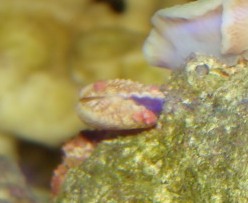 |
|
Invertebrate ID Help? Syconoid Sponges --
716/10
WetWeb-ers, Hello again,
<Hello, Drew, Lynn here this evening.>
I have another mystery critter for you to cut your teeth on
today.
<Go for it.>
A Cnidarian of some type seems likely, but I haven't found a
photo similar to my little beasties.
<Ah, you were looking in the wrong place!>
Attached are some photos of small (roughly 1/4") critters
that have recently been found infesting my rockwork and sump.
They are sessile and have a slender tubular body about the size
of a chubby grain of rice which projects perpendicular to their
chosen surface. At the free end is a structure (mouth/feeding
apparatus?) with a circular array of very short tentacles, less
than 1/3 the length of the body itself. They are the color of
oatmeal, or thereabouts.
<No worries, these are harmless/beneficial, filter-feeding
Syconoid sponges. There's an excellent close-up of one at the
FAQ titled 'Sponge Identification: Syconoid Sponges.
6/3/2009' at this link: http://www.wetwebmedia.com/SpongeID12.htm
. You can find more related FAQ's by entering the term
Syconoid in our Google search engine: http://www.wetwebmedia.com/Googlesearch.htm
>
As you can see in the pictures, they have a great liking for my
sump and have colonized it extensively.
<That's typical for these sponges.>
They are present on the rockwork as well, however, though the
highest concentrations seem to be underneath overhangs. Still,
some are present on the top of the rocks in full light and flow.
I can't say with confidence which conditions they're
favoring.
<These usually come and go in boom and bust cycles, especially
in new systems. In more mature systems, high numbers can indicate
a problem with excess nutrients.>
(Given the difficulty I had photographing them, I'm inclined
to determine that they do not show up on film and therefore must
be vampires or some faction of The Undead...)
<Heheee! No need to get out the garlic and wooden stakes for
these guys!>
Any ideas?
<Yep, if this is a new (or semi-new) tank, don't worry
about it. The large numbers you're presently seeing will
reduce to a manageable number all on their own. You'll likely
end up with a few here and there in the display and a bunch in
the sump. If this is a mature system, you've likely got a
nutrient problem going on. For more information on nutrient
control, please see the following link: http://www.wetwebmedia.com/nutrientcontrol.htm
>
Drew
<Take care, Lynn Z>
|
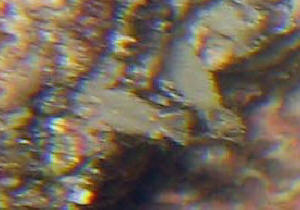
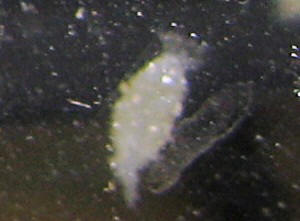 |
Re: Invertebrate ID Help? Syconoid
Sponges -- 7/17/10
<Hey Andrew!>
Lynn you're unflappable; first my double-pistoled shrimp and
now this...amazing!
<Heeee! This one was easy. The double-barreled pistol shrimp was
a new one for me as well. I'd read that Alpheids could
potentially have two snapping claws but had never come across one.
I'd say we both learned something with that query!>
I looked through the archives and find that these guys (or
their
near fellows) often appear as a fuzzy ball or Q-tip shaped object
as well:
<Yep, they're commonly called Q-tip or Pineapple
sponges.>
..turns out my girlfriend and I had noticed just such an organism a
week or two ago and when she suggested it may be related to the
present outbreak I told her she was silly and to leave this to the
experts...... obviously flowers are already en route, this will be
a long weekend.
<Hehehee! Sounds like you've got some 'splainin' to
do, and perhaps some wining and dining as well!>
FWIW, this tank has only been running since March,
<Yep, there you go. That's a fairly new tank.>
..albeit with rock and sand from an established tank. We're in
the midst of a hair algae outbreak as well, so I suppose your
nutrient problem hypothesis can't be ignored.
<Yep, something's feeding the hair algae and sponges. Be
sure to keep up with your water changes, and if you have a skimmer,
make sure it's in good working condition. Also, make sure
you're not over-stocked or over-feeding regarding livestock.
Finally, check your source water for nitrates and phosphates, and
if you don't have it already, get a light for your sump and set
up a section where you can add a macroalgae, like Chaetomorpha. The
macro will go a long way to controlling the hair algae and nutrient
issues. Do read through the related article mentioned in the last
email as I've only glanced over the topic here!>
Thanks for the help, as always.
<Always a pleasure, Andrew.>
Andrew
<Take care, Lynn Z> |
Tip On Goniopora <fdg., ltg.> And A Question On
Frogspawn <beh., id.> 6/23/10
Greetings crew!
<David>
First off, your site is incredible and I use it as my saltwater aquaria
bible.
<Thank you, and glad to hear.>
My first point is a tip with Goniopora or flowerpot coral since it
seems to be a delicate creature and hard for some to take care of.
<I agree.>
I have had the red variety of Goniopora in my tank (55gal with skimmer,
charcoal media filter and 29gal refugium and 216W T5 with 2 10K and 2
Actinic and moon lights on a 12hr timer) with Zoas, Palys, Xenia,
multiple
LPS (Favias, FS, chalice), Rics and Shrooms, a few softies (chili and
orange carnation), a rose BTA and a Tube Anemone. Fish are Six Line
Wrasse, Black Saddle Perc Clown, Orange Perc Clown, fire goby and a
Blue Hippo
Tang. Said Goniopora has been healthy, blooming and encrusting for 5
months now. I feed Mysis, brine soaked in Selcon then drained and
seaweed (for the tang) and zooplankton (targeted) and phytoplankton
(twice a week). The
phyto is for softies and Goniopora. I read a study, possibly on this
site, that studies of dissected Goniopora in the wild found the
majority of the stomach contents to be phytoplankton.
<I have read similar reports to that extent, and that Goniopora
cannot survive on photosynthesis alone, but depends on phyto for 70% of
it's diet.>
I also found that, my species in my tank, seemed to be very sensitive
to light changes even light temp. Due to a mix up at the LFS I had to
run 3 10K bulbs and 1 actinic instead of the 2 and 2 normal setup. This
ran for 4 days before I could correct and caused my flowerpot to
completely recede into the skeleton and close the openings to the
polyps. Once I fixed the lighting temperature SNAFU, it started to
bloom immediately! Hope some of this helps.
<Agree, actinic doesn't do much for photosynthesis.>
Oops, forgot tank parameters:
SG-1.025
PH-8.3
temp-80
Am-0
Nitrite-0
Nitrate-fluctuates between 0 and 10
Calc-480
Alk-9
MG-1260
Phos-0-0.25 I know...no readable phosphate.
weekly 5gal water changes of RO/DI
1/2 cup dark skimmate every 3-4 days
So my question about the frogspawn is this:
I have researched on your site and others regarding the anatomy and
physiology of this species (mine is the green and purple branching
variety) regarding feeding parts. I know about sweeper tentacles
(mainly for defense and attack) and the mouth located at the center of
the head. The part that I am curious about is a tube like opening on
each head separate from the mouth. This opening can close and retract
and when it is open a translucent fanlike appendage darts out, opens up
and rotates to catch particulate and then retreats. This happens
constantly through out the day and night; pretty cool to watch. I have
not been able to find any info on this on your site. Is this a filter
feeding mechanism to add to the photosynthetic algae and carnivorous
eating habits of this LPS?
<Mmm, I'm not aware of that physical behavior, and in searching
Borneman's book, came up with nothing. I know Euphyllias have
developed several feeding strategies and whether this is one of them, I
don't know. As crazy as it sounds, it seems as though you have a
barnacle of some type growing in the Frogspawn. Your description of
this sure resembles a barnacle to me. Bob, am I losing it, or do you
have any input?><<Mmm, this IS likely a Cirripedian... a
Barnacle; but could be a filter feeding member of other arthropod
groups (crab, shrimp). RMF>>
Thanks for your time!
<You're welcome. James (Salty Dog)>
-David
|
Re: More re: tip on Goniopora and a question on
frogspawn 6/25/10
I have attached a few pics, one where the FS has receded into the
skeleton and one where it is starting to extend. The interesting
thing is that each head of the FS has one and the placement is
also the same. hopefully the pics can shed some light on
this!
<Mmm, the tube is likely resultant from the "space
""parasite"" and the stony coral's
interaction. This still may be a Barnacle... Do please look at
today's Daily FAQs on WWM, as another has written in w/
images of his "fanning" commensal organism.
BobF>
|
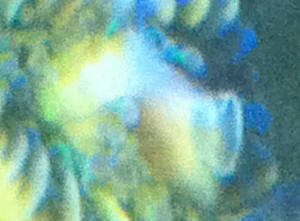 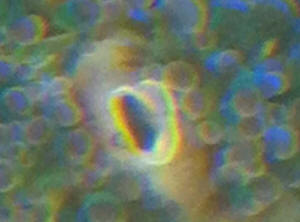 |
|
Re Tip On Goniopora <fdg., ltg.> And A Question
On Frogspawn <beh., id.> 6/23/10 6/25/10
Ok so I was reading the dailies today and came across this query
about the "translucent fanlike appendage" I also have
the exact same coral that he is referring to and tried my best to
get a picture of it a little blurry but you can definitely make
out its general shape I don't know if my fanlike creature is
the exact same as his but what I do know is that it does resemble
a shrimp that pokes out.
<I see this>
I can definitely see what appears to be two small legs that sit
on top of the opening when this creature comes out
and the "mouth" of the animal appears to be the same
multiple appendage moving very quickly like say a cleaner shrimp
does when it 's eating. I attached a few photos for you guys
to look at. Also in picture coral 21 I was wondering what those
white and green tube like things are. Are they the beginning of a
small colony of cluster dusters?
<These are a green algae/Chlorophyte, genus Neomeris>
Kris
<Bob Fenner>
|
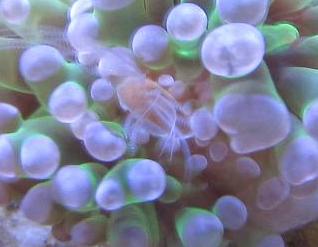 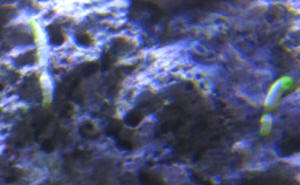 |
|
Squishy Critter ID 6/23/10
Hey WWM,
<Hi Mike>
I recently purchased a coral frag from my LFS. After moving the
frag out of the bag it was in, I found that the water contained
these little slug-like creatures... lots of them. I put them in
some Tupperware to see if they were worth adding to my tank, but
couldn't find out what they were. I took as good of a picture
as I could get. They are brownish and relatively active.
They stick to surfaces and have worm-like movement. What are
these little critters?
<These look like Stomatella snails to me.. it's difficult
to see, but do they have a very small shell on the top, and when
you pick them up the tail falls off? If so, then that is what you
have, a beneficial organism.
http://www.reefkeeping.com/issues/2004-05/rs/index.php>
THANKS!
<No problem>
Mike
<Simon>
|
 |
|
Re: Squishy Critter ID 6/24/10
<Mike>
They are very small, <How small?> that's about as good
as I can take a photo of them with my camera. There are probably
about a dozen visible ones that hitchhiked on a 4" orange
Zoanthid frag. They don't have shells, toward their back they
are reddish brown. Does the shell form as they grow larger?
<The shell is difficult to spot. Does the tail come off when
you pick one up as I described? Simon>
Re: Squishy Critter ID 6/25/10
<Hello Mike>
They are about 1mm in size and smaller.
<Mmm, then these could actually be Planaria
http://www.wetwebmedia.com/flatworms.htm>
We were only able to pick them up on our nails and using an eye
dropper, and nothing fell off of them.
<Ok. Quite possibly flatworms then. Not too much to worry
about unless they get to plague proportions>
I guess I'll wait a bit and see what develops. From your link
it said that they mature quickly so hopefully we be sure within a
month or so.
<Simon>
|
Avatar movie-- is it just me? Mar. invert. ID
5/25/10
Hello,
Anyone else notice that a lot of the "vegetation" on Pandora
looks a lot like various marine invertebrates?
Cheers,
Sara
<Oh heck yeah... Specially the giant fanworms/Featherdusters.
B>
|
|

